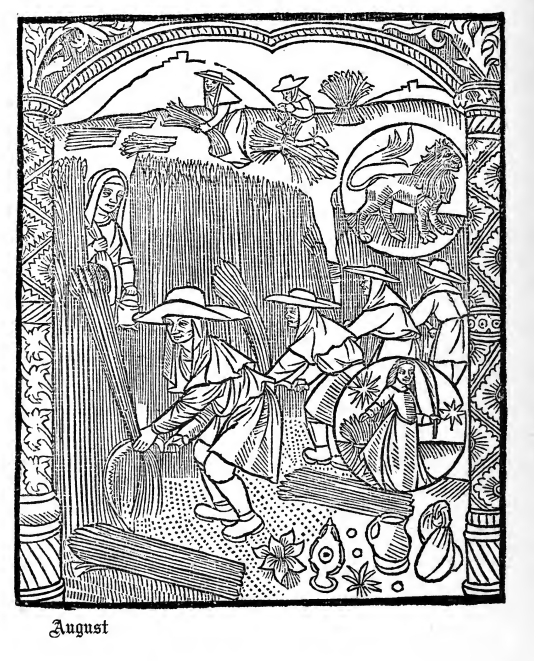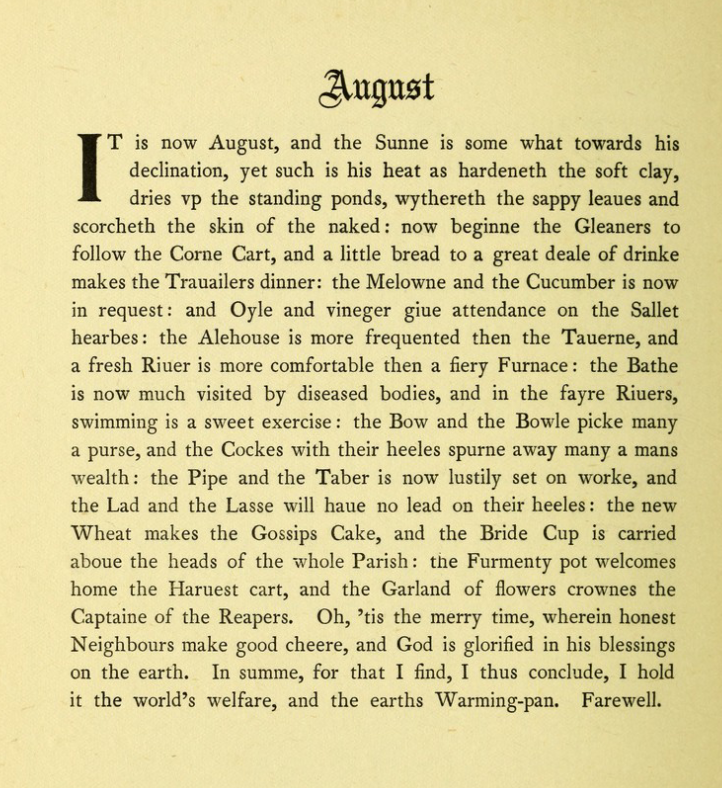
August was originally ‘sextilis’ or the 6th Month of the ten-month Roman Calendar. It became the 8th Month with the addition of January and February (by tradition during the reign of King Numa Pompilius). It was changed from a 29-day month to a 31-day month in the reforms of Julius Caesar and was renamed August by a sycophantic Senate trying to flatter the divine Octavian, Emperor Augustus. (more about the Roman Calendar here)
In modern Irish, it is Lúnasa, which means the month of the festival of Lughnasa. In Welsh, it is Awst which comes from the Latin. In Anglo-Saxon: the Venerable Bede, writing in the 8th Century, says August is Wēodmōnaþor the Weed Month, named, he says, because of the proliferation of weeds. Why does that seem such an unsatisfactory name for August? An early Kentish source calls the month Rugern – perhaps the month of the harvest of Rye? (Winters in the World by Eleanor Parker).
The 15th Century illustration in the Kalendar of Shepherds, above, shows that the Harvest is the main attribute of the Month, and the star signs, Leo and Virgo.


The 16th/17th Century text in the Kalendar of Shepherds gives an evocative insight into the month. (more about the Kalendar here)

For the Anglo-Saxons, August brings in the harvest period, the most important months of the year, where the bounty of the earth needs to be carefully collected, enjoyed but not wasted. It begins with the festival of Lammas, which derives from the English words for bread and mass, when bread made from the first fruits of the harvest is blessed.
In Ireland, it is one of the great Celtic quarter days, named Lughnasa, the festival of the God Lugh, celebrated with games, fairs, ceremonies. Called Calan Awst in Wales, it is the festival of August. The quarter days, are halfway between the Solstices and Equinoxes – Samhain (1 Nov) Imbolc (1 Feb), Beltane (1 May) and Lughnasa (1 Aug) and all are, or can be seen as, a turning point in the farming year.
The Gallic Coligny ‘Celtic’ Calendar records August as a ‘great festival month. The stone-carved Calendar was found near Lyon, whose Roman name was Lugodunum, named after the Gaulish God Lugos, to whom, the Irish Lugh and the Welsh Llew Llaw Gyffes are probably related. He has an unstoppable fiery spear, a sling stone, and a hound called Failinis. The Romans associate Lugos with Mercury, and the Church with St Michael.
Lughnasa, (meaning the festival of Lugh) was founded by the God himself to honour his foster mother Tailtiu at Brega Co. Meath. Tailtiu became one of Ireland’s greatest festivals, springing from the horse races and marital contests set up by Lugh. In Gaelic Scotland it is called Lunasuinn, and Laa Luanistyn in the Isle of Man.
The festival is a harvest festival, celebrating the ripening of wheat, barley, rye, and potatoes. It is 6 months after Imbolc and records the ending of lactation of lambs and the beginning of the tupping season. It can be celebrated by climbing hills, visiting springs, wells, lakes and eating bilberries. (Myths and Legends of the Celts. James MacKillop).
Discover more from And Did Those Feet
Subscribe to get the latest posts sent to your email.
